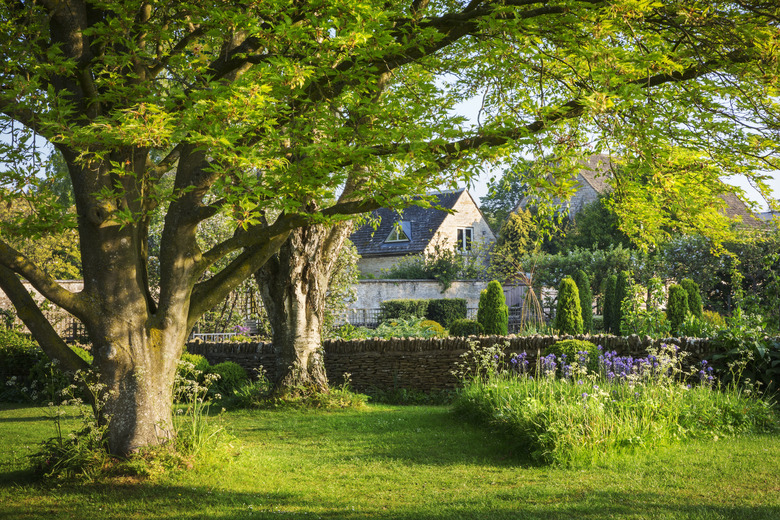Complete Guide To Spring Lawn Care
When cold winter months start to fade away, it's time to get started on your spring lawn care so you can enjoy a beautiful, lush lawn during summer. However, unless you're a professional greenskeeper, chances are you aren't familiar with all the proper steps of caring for a lawn season by season. Even if you have a decent idea of when to fertilize, mow, dethatch, aerate, start new grass seed or kill off weeds, it never hurts to review a list of spring lawn care tips before getting started so you can keep your grass as healthy as possible.
Spring Lawn Care Cleanup
Before doing anything else, you'll need to clean up your yard. If you have snow piles, spread them out to encourage melting and prevent them from smothering the grass. Rake any dead leaves, pine cones and grass. Use a spring-tine rake and pull up with some force to remove any dead grass, including matted clumps that were affected by snow mold, as these can smother any new growth. Rake only when the soil isn't muddy or soft so you don't accidentally pull up healthy grass.
When to Apply Herbicides
Weeds take off in spring, so weed control is important this time of year. It's best to use pre-emergent herbicides, like those targeting crabgrass, in early spring as soil temperatures approach 55 degrees Fahrenheit. Broadleaf herbicides for plants such as dandelions are only really effective if applied in fall when they are storing food before their dormant period, so by the time you start seeing them, it's too late to do anything other than pull out the plants by hand.
Identifying Your Grass
Determining whether you're growing warm-season or cool-season grass is important, as spring lawn care tips vary dramatically based on grass type. Cool-season grass goes dormant during the summer, so you need to prepare it to survive the upcoming hot weather. On the other hand, warm-season grass is in an active growth phase during summer, so spring lawn care tips for these grasses should focus on improving its health as it comes out of its dormant phase.
Most people in the North have cool-season grasses, which is why they are also called "Northern grasses," while those in the South have warm-season grasses, also known as "Southern grasses." If your grass starts thinning in cold winters, it's warm-season grass. If it starts to die off during particularly hot summer weather, it's cool-season grass. If you live in a region between these two areas and your grass survives year-round, you can easily identify the type of grass if you are aware of the species. A quick web search will tell you that Bermudagrass is a warm-season grass, for example, or that ryegrass is a cool-season grass.
If you're not sure of your grass species and it survives year-round, contact your local county extension to see if they could help you identify it.
When and How to Fertilize Your Lawn
Many people are eager to get their grass growing and want to fertilize as the snow begins to melt in order to kick-start the growth period, but applying fertilizer to warm-season grass too early can encourage shoot growth rather than healthy roots, making it more susceptible to disease, pests and hot weather.
Instead of fertilizing early, wait until the soil temperature reaches 55 degrees Fahrenheit, which is when your grass will begin growing again. In most of the Northern United States, this means waiting until sometime around mid-April. On the other hand, cool-season grasses respond best to fertilizer applied in late summer through autumn.
For either grass type, use a mechanical spreader to evenly spread a fertilizer high in nitrogen, such as a 20-5-10 mix. This will encourage lush, green growth and prepare the lawn for the upcoming growing season. Always use a slow-release fertilizer that will keep releasing nutrients over time. Fast-acting fertilizer can burn grass.
Instead of randomly broadcasting fertilizer, it's always best to follow the recommendations of a soil test. Otherwise, your lawn may succumb to diseases because of insufficient or excessive fertilization.
Watering in Spring
If you live in an area where it snows, one of the first things you'll need to do in early spring is wash away any salt residue from the grass. If your lawn has started to brown and become withered near your sidewalks or driveway, soak the area with water for a few days to rinse the salt out of the soil. If the damage is particularly bad, remove the dead grass, work a gypsum soil conditioner into the soil and reseed.
You don't need to start regular watering until the grass has started its active growth phase. If you have warm-season grass and mild winters, you'll need to give your lawn 1 inch of water every week as long as it hasn't rained. With cool-season grasses, wait until your grass starts growing again before watering. In fact, having slightly dry soil when cool-season grass starts growing again will encourage the roots to grow deeper.
When and How to Mow Again
As a rule of thumb, you'll need to mow every other week, or even once a week depending on the rate of growth, starting as soon as the grass begins to grow. This is usually when the weather is around 65 degrees. Before that time, tune up your mower and sharpen the blades.
For cool-season grasses, set the mower height a little higher than the average recommended height for that species so you don't stimulate too much growth prior to the summer dormancy period. For most warm-season grasses, set the mower height according to the species's recommended height throughout spring. Interestingly, Bermudagrass is an exception, as it should be cut down to only 1/2 inch tall the first time you run the mower to help encourage the plant's growth phase and remove any unhealthy blades.
No matter what the species, never mow more than 1/3 of the grass blades at once. When mowing the first few times in spring, rake up the clippings to avoid spreading any disease pathogens that may have overwintered on your turfgrass, but after that, leave clippings on the ground to provide nutrients to your lawn.
Treating Bare Spots
The harsh conditions of winter often result in damage to your grass from pests, snow, salt and more. Seeding for cold-season grasses is best saved for fall, but you can still successfully fill in bare spots when air temperatures are regularly 60 degrees. Warm-season grasses are best planted in spring when the weather is routinely 70 degrees. Always reseed only after removing weeds and moss from the area. Be sure to keep the soil moist in areas where you have planted grass seed.
Dethatching and Aeration
Both dethatching and aerating make it easier for air, nutrients and water to reach the roots of the grass, but because both potentially cause damage to the grass, these should only be done during the peak growth season, meaning only warm-season grasses should be dethatched or aerated in spring, and even then, wait until you've mowed three times to ensure the grass is in its peak growth period.
Not all lawns need dethatching or aeration. Thatch is the brown layer of dead plant material, grass crowns and roots above the soil's surface and below the green grass blades. You'll need to dethatch your lawn if this layer is over 1/2 inch thick. You'll need to aerate if you notice that your soil is compacted and doesn't seem to be absorbing water or if the grass is stunted and thinning.
Dethatching should be done before aerating in order to remove the excess plant material, and then aeration should be done to help loosen the soil below.
References
- BioAdvanced: Getting Ready For Spring Lawn Care
- Iowa State University Extension and Outreach: Yard and Garden: Timing and Applying Broadleaf Lawn Herbicides
- Gilmour: 7 Spring Lawn Care Tips for the DIY Gardener
- Today's Homeowner: Spring Lawn Care Guide
- Baker Lime: Lawn Care Calendar for Cool-Season Lawns
- Fix: How to Recover Landscaping from Salt Damage
- Pennington: How to Identify Your Lawn Grass


